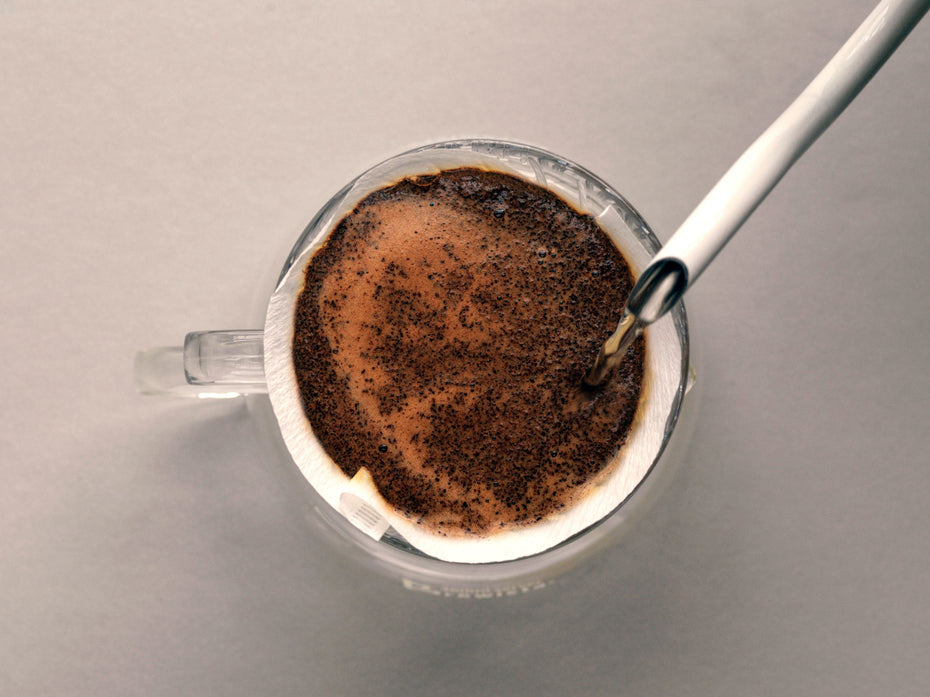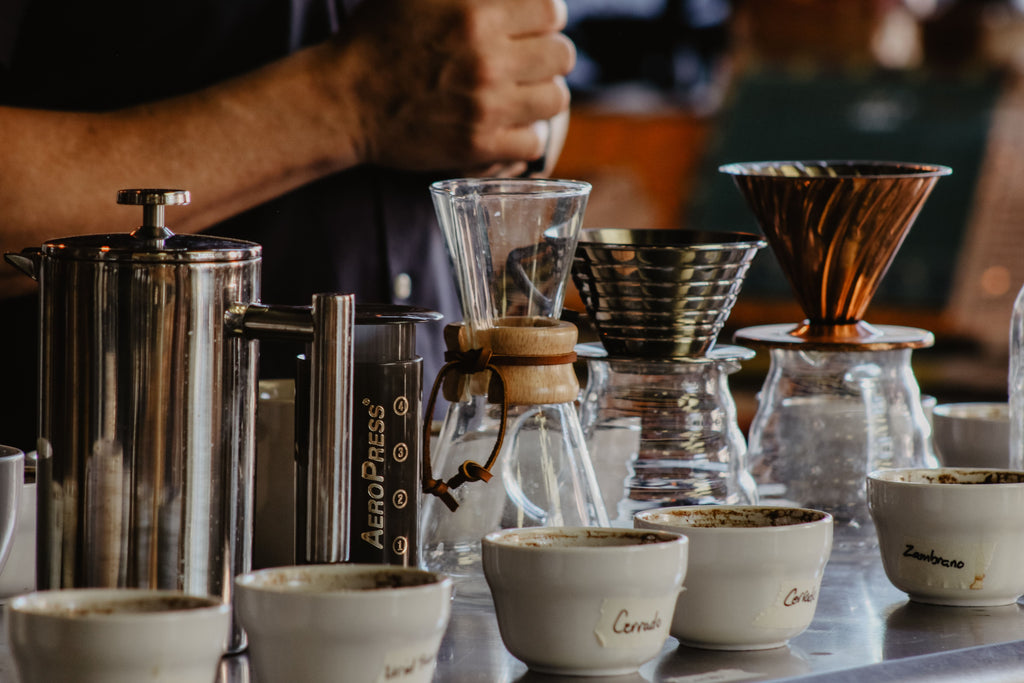
4 Must-Have Tools for Making Pour-Over Coffee Like a Barista
Your morning cup of coffee is a beautiful blend of art and science.
Baristas train for months to make sure your coffee is a delicious and enjoyable drink, not just a caffeine kick. Enjoying a pour-over of your local cafe's newest single-origin coffee should be a delicious experience every time.
Why is coffee made by a barista so sweet and exciting? There has to be some kind of secret barista code that teaches you the ways of coffee brewing mastery, right? Sorry to disappoint you, but there is no such code... or club... or even a secret handshake.
The truth is, anyone can learn to make mouth-watering coffee just like the baristas at the cafe down the street, including you! All you need is a bag of freshly roasted specialty coffee, a little practise, a lot of patience and 4 easy-to-use tools. Once you gather these tools and learn to use them well, you'll be ready to brew a professional pour-over coffee at home.
But, before you learn about your new favourite coffee brewing tools, you need to know about extraction - the secret science behind great tasting coffee.
Extraction: the Key to Great Coffee
Water poured over ground coffee dissolves and carries away up to 30% of the coffee's mass in a process called "extraction". Mastering this geeky coffee concept is the secret to brewing great coffee.
Coffee is made of four basic compounds that will either dissolve or be carried away by water. It consists of fruit acids, sugars, lipids and carbohydrates. Each component adds unique flavours that, when combined in the right ratio, gives you a delicious cup of coffee. Luckily, they extract in order, making it easy for you to control your coffee's flavour.
The sugars in coffee are your best friends. Perfectly extracted coffee showcases its sweetness with acidity and bitterness as sidekicks. Extract too little of the sugars and your coffee will taste sour. Extract too many carbohydrates and they will overpower the sweetness with a dry, bitter flavour.
When brewing pour-over coffee, your goal is to extract as many sugars as possible. This is to balance out the quickly dissolved acids without letting too many of those pesky carbohydrates into your cup (the lipids are caught by your filter, so no need to worry about those).
Extraction is a delicate process. These four must-have tools will help you master it and brew sweet and balanced coffee every time.

Tool 1: A Pour-Over Coffee Dripper for Consistency
The first tool you'll need to brew coffee like a pro is your very own pour-over coffee dripper. Making coffee like your a barista takes care, precision and concentration. Pour-over coffee dripper like the Chemex, Hario V60 or Kalita Wave, give you complete control over every cup you brew.
It might seem over-the-top to brew your coffee one cup at a time, but great baristas are all about this kind of nerdy precision.
If you want to brew coffee like a trained barista, you'll need to ditch that cheap 10-cup coffee pot and invest in a pour-over coffee dripper. The cheap brewers carelessly spray steaming water onto your coffee grounds. If you open up the lid and watch it brew, you'll see it spraying some grounds so hard, they fly out of the basket while others barely get wet. This leads to uneven extraction, making your coffee taste both sour and bitter.
Instead, grab whichever pour-over dripper you like best and its matching paper filter. Your dripper will be the foundation for your perfect cup of coffee.
Tool 2: A Gram Scale for Precision
Once you pick out your pour-over dripper, you'll need a scale to make sure you are using a precise coffee-to-water ratio.
A tablespoon won't do if you want to take your coffee brewing to the next level. Using a gram scale will let you dose by weight instead of volume. Coffees of different varieties, regions and roast levels will vary widely in volume. A tablespoon of a dense Ethiopian coffee may weigh 7g, while a dark roasted Brazilian coffee in the same scoop may only weigh 5g. That difference will drastically change your coffee's extraction.
Remember, the more precise the better. Find a scale accurate to .1g to make sure you have complete control over your ratio. For a pour-over, most baristas use a ratio of 1g of coffee to 15-17g of water.
Your coffee to water ratio is a trade-off between extraction and body. A higher water ratio (a "looser" ratio like 1:18 or higher) will increase extraction but give your coffee a thinner body. Using less water (a "tighter" ratio like 1:14 or lower) will extract less and make your coffee's body heavier. Usually, it's best to use your ratio to figure out how thin or heavy you like your coffee to feel.
The next tool - a burr grinder - will be able to fix any extraction problems.

Tool 3: A Burr Grinder for Freshness
As roasted coffee contacts oxygen, the flavourful compounds break down in a process called oxidation. As those compounds break down, your coffee loses flavour and complexity and develops a boring, stale quality.
Whole bean coffee stays fresh much longer than ground coffee because it contacts less oxygen. The outside of the roasted bean works like a shield, protecting the rest of the coffee form the staling power of air. Grinding coffee takes away that protection by exposing every little coffee particle to oxygen.
To combat this, you should wait to grind your coffee until you're ready to brew. The tool you need to make that happen is your very own coffee grinder.
When you look around for coffee grinders, you'll see two main types - blade and burr. Blade grinders use a propeller-like blade in the bottom of a container to bash your coffee into small enough pieces for brewing. Burr grinders use an abrasive burr spinning against a stationary surface to crush coffee down to size.
A burr grinder will give you the most control over the size of your grind. Blade grinders are inconsistent, creating large coffee chunks that will under-extract. It can also create small, dusty fines that will quickly over-extract and clog up your pour-over dripper. Burr grinders, on the other hand, create a much smaller range in grind size, leading to more even extraction and a delicious cup of coffee.
The right grind setting for your pour-over depends on your grinder and dripper. Larger pour-over dripper like the Chemex need a medium-coarse grind, slightly smaller than sea salt. Small drippers like the V60 and the Wave use a medium-fine grind, similar in size to sand.
You can have a play with the grind size to find your perfect brew. If you notice your coffee tastes sour and under-extracted, try a finer setting on your grinder. If it tastes bitter, chalky or leaves you feeling like you need a glass of water it is most likely over-extracted. Try brewing with a coarser grind.
Tool 4: A Gooseneck Kettle for Control
The last tool you need to brew pour-over coffee like a pro barista is a kettle with a long, curved spout called a "gooseneck". The narrow, curved spout gently pours water onto your coffee, giving you complete control over where, when and how fast your coffee extracts.
While most regular coffee makers spray water over the grounds, a gooseneck kettle evenly wets every little grain of coffee, giving you even more control over your coffee's extraction. You'll no longer have a funky blend of sour and bitter flavours like you taste with a drip coffee pot. Instead, your coffee will taste more consistent.
What needs to be noted is that consistent doesn't always mean "delicious", but it does mean "easy to fix". If your coffee is consistent you'll be able to taste whether it is sour and under-extracted or bitter and over-extracted. You can then go back to your grind and make small adjustments until you find the setting that brews your perfect cup of coffee.
Our Handoff
You can brew pro-level pour-over coffee by adding these 4 must-have tools to your home coffee bar. A pour-over dripper, gram scale, burr grinder and gooseneck kettle will help you master extraction by giving you consistency and control.
There is no industry secret to brewing great coffee. In fact, most baristas would gladly share their favourite techniques, brands, recipes, and coffees with you if you ask! The only difference between you and an expert barista who's mastered the craft are tools and practice.
Now that you have your tools, you need to practice. Learn how each tool changes your coffee's flavour. Only change one variable at a time until you master extraction. Look for sour or bitter flavours and adjust your grind size or your ratio accordingly. As you get to know your tools, you'll learn to brew great coffee at home every time - just like the baristas at the shop down the street.





